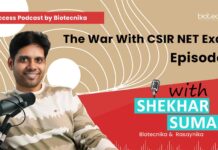Latest Blood Cancer Research Updates – Voice of Biotecnika
Voice of Biotecnika – Episode No: 40
Today’s podcast is all about Believing Miracles Can Happen. We are going to talk about Cancer today, with a special focus on Blood cancer.
Blood Cancer is the abnormal or uncontrolled growth of blood cells. The most commonly diagnosed blood cancers are non-Hodgkin lymphoma, chronic lymphocytic leukemia, acute myeloid leukemia, acute lymphoblastic leukemia, and multiple myeloma.
Listen to the podcast on SoundCloud
Non-Hodgkin Lymphoma occurs when large B-cell lymphoma, grows rapidly, and follicular lymphoma grows slowly. Chronic lymphocytic leukemia (CLL) occurs due to uncontrolled growth of B lymphocytes, which is a type of white blood cell. Acute myeloid leukemia (AML) is fast-growing cancer, common in adults in which the bone marrow produces abnormal amounts of white blood cells, red blood cells, and platelets. Acute lymphoblastic leukemia (ALL) is a fast-growing type of leukemia in which the bone marrow makes too many immature lymphocytes. Multiple myelomas occur when the body makes too many plasma cells, which develop from B lymphocytes in the bone marrow.
Cancer is a life-threatening disease, is considered a taboo in many cultures. But now its time, not to be
depressed as new research offers a ray of hope for treatment as researchers are contributing immensely towards controlling the untamed growth of bold cancer cells.Acute myeloid leukemia (AML) is one of the most common and lethal acute leukemias. According to the American Cancer Society every year 19,520 cases are diagnosed and about 10,670 people die annually from it, due to the increase of malignant myeloid progenitor cells. It’s a deadly disease as after initial diagnosis only twenty-five percent of patients survive beyond five years.
Why there is no permanent cure for it because the detailed mechanisms for the occurrence and progression of acute myeloid leukemia are incompletely understood. Presently, the treatment strategies for patients with this disease include chemotherapy, targeted therapy, and hematopoietic stem cell transplantation. Though the significant development in treatment strategies has enhanced the therapeutic outcomes of patients with acute myeloid leukemia over the last few decades. But nonetheless, a large number of patients face relapsing of the disease and hence die of the disease. Therefore there is an utmost need to understand the molecular processes and mechanisms which are responsible for acute myeloid leukemia development and progression of the disease. The mechanisms are of great importance as it helps to develop reliable therapeutic approaches for patients with this disease.
A group of researchers at the Ludwig Boltzmann Institute for Cancer Research and the Medical University Vienna has now made some breakthrough to tame this disease. Acute myeloid leukemia is carried by a mutated, oncogenic isoform of the protein CCAAT/enhancer-binding protein alpha or C/EBPα, the interaction of the mutated protein with an epigenetic regulator, MLL1 complex, if the MLL1 complex was functionally inhibited, acute myeloid leukemia cells underwent cell death. Acute myeloid leukemia patients harbor mutations in the CEBPA gene, which encodes the transcription factor C/EBPα. One truncated protein C/EBPαp30 isoform interacts with the MLL1 complex to control gene expression.
CRISPR/Cas9-mediated mutagenesis of MLL1 results in proliferation of arrest and myeloid differentiation in C/EBPαp30-expressing cells. OK first let me tell you what is CRISPR. CRISPR technology is a very powerful tool for editing genomes. These are specialized stretches of DNA. CRISPR derived protein Cas9 is an enzyme that acts like a pair of molecular scissors, which can cut strands of DNA. Further, it was found that CEBPA-mutated hematopoietic progenitor cells are more sensitive to pharmacological targeting of the MLL1 complex. When the inhibitor is added it impairs proliferation and restores myeloid differentiation potential in mouse and human acute myeloid leukemia cells with CEBPA mutations. Finally, they identified the transcription factor GATA2 is a direct critical target of the p30-MLL1 interaction. They further discovered that C/EBPαp30 requires the MLL1 complex for regulating oncogenic gene expression and that CEBPA-mutated acute myeloid leukemia is very sensitive to perturbation of the MLL1 complex. These findings identify the MLL1 complex as a potential therapeutic target in acute myeloid leukemia with CEBPA mutation.
Apart from the above research new drug compounds have been isolated that show promise in treating acute myeloid leukemia. Purdue University researchers have shown promise in treating acute myeloid leukemia. They are of the opinion that tyrosine kinases (TKs) drive the survival and proliferation of both normal and malignant cell types. These TKs are usually mutated in acute myeloid leukemia and hence they targeted it. In 30 percent population of acute myeloid leukemia patients, a mutation is caused by a kinase known as FLT3. Inhibitors of FLT3, like Radapt and Gilteritinib which was approved in 2018 by the U.S. Food and Drug Administration, have shown immense promise in treating leukemia. But it was found that acute myeloid leukemia patients with FLT3 inhibitor therapy often relapse due to secondary mutations in the FLT3 and existing treatments have not been fully successful in treating those cases.
Therefore the researchers have developed novel compounds that work not only on acute myeloid leukemia with common FLT3 mutation but also on drug-resistant acute myeloid leukemia harboring secondary mutations.
Researchers working at the Department of Hematology China were of the opinion that different microRNAs (miRNAs) get aberrantly expressed in acute myeloid leukemia and miRNAs play the role of protagonist in tumorigenesis and progression of acute myeloid leukemia. miR-628-3p (miR-628), is one such miRNAs which get dysregulated in many human cancers, also exerts anti tumorous roles in different cancer types. Their studies were aimed at exploring the possible mechanism underlying the function of miR-628 in acute myeloid leukemia cells.
The expression of miR-628 was downregulated in patients with acute myeloid leukemia and acute myeloid leukemia cell lines. Insulin-like growth factor 1 receptor (IGF-1R) was identified as a direct target gene of miR-628 in acute myeloid leukemia cells which gets upregulated in patients with acute myeloid leukemia while IGF-1R knockdown led to the tumor-suppressive effect of miR-628 in acute myeloid leukemia cells. It was found that miR-628 inhibited the activation of phosphatidylinositol-4,5-bisphosphate 3-kinase (PI3K)/protein kinase B (Akt) pathway in acute myeloid leukemia cells which is suggestive of its potential role as a therapeutic target in patients with this life-threatening malignant tumor.
Another latest research to control this disease is through the development of engineered T cells which can treat acute myeloid leukemia. Though it is a challenging task thinking about the difficulty in target selection and the requirement for robust T-cell expansion and persistence. The team of researchers at Pediatrics, University of Michigan have designed a T cell which can be stimulated to kill acute myeloid leukemia cells by recognizing the acute myeloid leukemia-associated surface marker CLEC12A, through the release of a CLEC12AxCD3 bispecific “engager” molecule (CLEC12A-ENG). CLEC12A-ENG T cells are in turn activated by CLEC12A, which are not harmful to hematopoietic progenitor cells.
Thus it was shown to exhibit antigen-dependent acute myeloid leukemia killing. They also coupled this with triggering the expression of a chimeric IL7 receptor having an ectodomain that in particular binds to a second acute myeloid leukemia -associated surface antigen, CD123. The resulting T cells, CLEC12A-ENG.CD123IL7Rα T cells have displayed improved activation upon dual-target recognition, kill acute myeloid leukemia, and exhibit antitumor activity in xenograft models. Expression of the chimeric IL7R which is targeted to a second tumor-associated antigen would improve T-cell activity against the hematological monsters.
Another group of researchers further showed that RNA-binding proteins (RBPs) are essential modulators of transcription and translation, which is often dysregulated in cancer. They assessed the role of RBP in human cancers using a comprehensive CRISPR/Cas9 domain-focused screen which targeted RNA-binding domains of 490 classical RBPs. This led to the discovery of a network of physically interacting RBPs which gets upregulated in acute myeloid leukemia (AML) and are very important for maintaining RNA splicing and acute myeloid leukemia survival. Targeting of one key protein of this network, which is RBM39, led to repression of cassette exon inclusion and promoted intron retention within mRNAs which encodes HOXA9 targets as well as in other RBPs which are preferentially required in acute myeloid leukemia. RBM39 could not perform splicing which further resulted in preferential lethality of spliceosomal mutant acute myeloid leukemia, thus providing a strategy for the treatment of acute myeloid leukemia which has RBP splicing mutations.
Recently one more interesting research showed that Autologous Stem Cell Transplantation can be considered a viable postremission therapy for intermediate-risk acute myeloid leukemia as a complete remission when there is absence of a matched identical sibling.
Although allogeneic stem cell transplantation (alloSCT) is already considered a curative strategy for acute myeloid leukemia, the efficacy of autologous stem cell transplantation (autoSCT) for patients without a matched sibling donor was never very clear. What is allogenic and autogenic transplant?. It is a collection of stem cells from a matching donor and transplanted into the patient to control the disease and restore the patient’s immune system. An allogeneic stem cell transplantation is different from an autologous stem cell transplant, wherein stem cells from the patient’s own body are used. They compared the survival number after alloSCT versus autoSCT for patients with intermediate-risk acute myeloid leukemia in first complete remission, by performing a meta-analysis of 11 clinical studies. The outcomes were relapse-free survival, overall survival, relapse rate, and treatment-related mortality.
The results showed that when compared with autoSCT, alloSCT showed better relapse benefits, further analysis based on donor category like matched sibling donor or matched unrelated donor of allogeneic stem cell transplantation showed the allogeneic stem cell transplantation from matched sibling donor rather than from matched unrelated donor had better overall survival benefits compared to autologous stem cell transplantation. For FMS-like tyrosine kinase 3 internal tandem duplications (FLT3-ITD) wild-type patients, alloSCT and autoSCT had comparable relapse-free survival and overall survival outcomes. Thus the above research suggests that when, in the absence of an available matched sibling donor, autologous stem cell transplantation remains a viable postremission therapy alternative in case of intermediate-risk acute myeloid leukemia in first complete remission, especially for FMS-like tyrosine kinase 3 internal tandem duplications wild-type patients.
So what we can conclude is…Cancer diagnosis and treatment is growing by leaps and bounds. The glass, however, remains half-empty as many types of cancers still defy treatment. So the need of the hour is to encourage more scientific research which can provide the lead in resolving most of the human suffering from cancer in the coming years. So young researchers out there…what are your thoughts on controlling this untamed animal-cancer. Do share with us.
 towards teaching and educating students. Having done her Ph. D. research on nanoparticles, She has a wide range of publications in the field of nanoparticles. Adding to her further achievements are CSIR NET and GATE qualifications and Gold Medal in Biochemistry and Chemistry.
towards teaching and educating students. Having done her Ph. D. research on nanoparticles, She has a wide range of publications in the field of nanoparticles. Adding to her further achievements are CSIR NET and GATE qualifications and Gold Medal in Biochemistry and Chemistry.







































